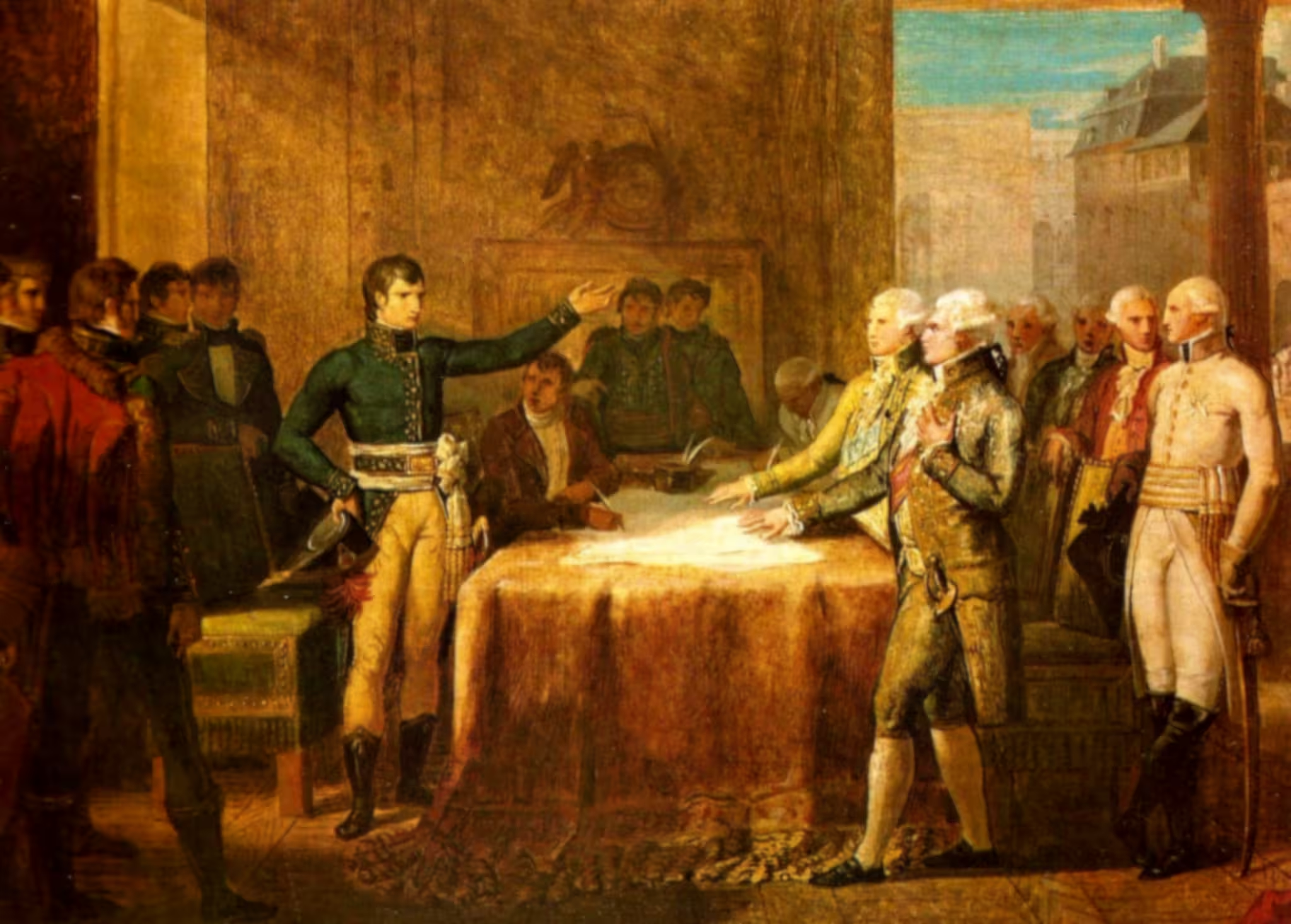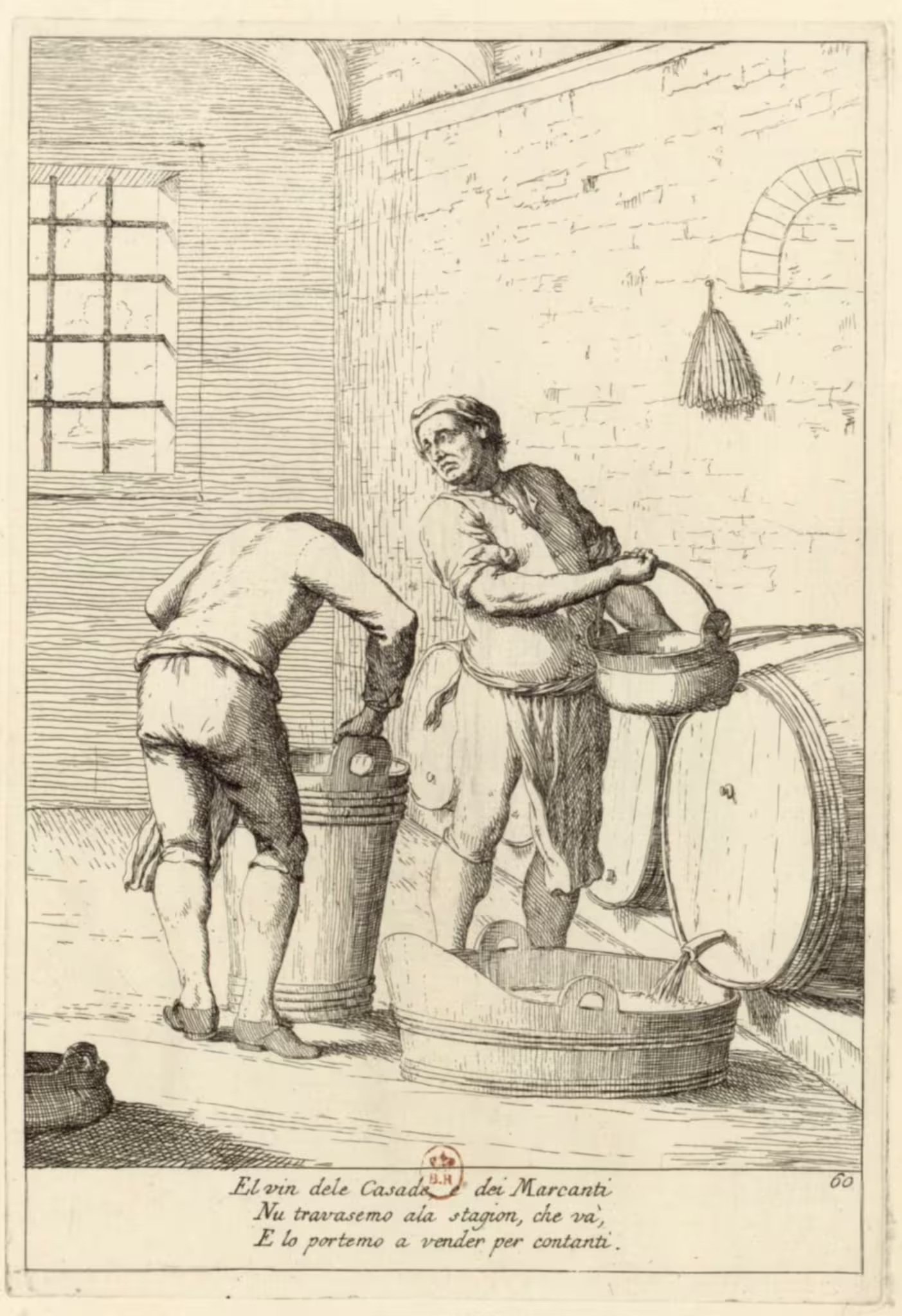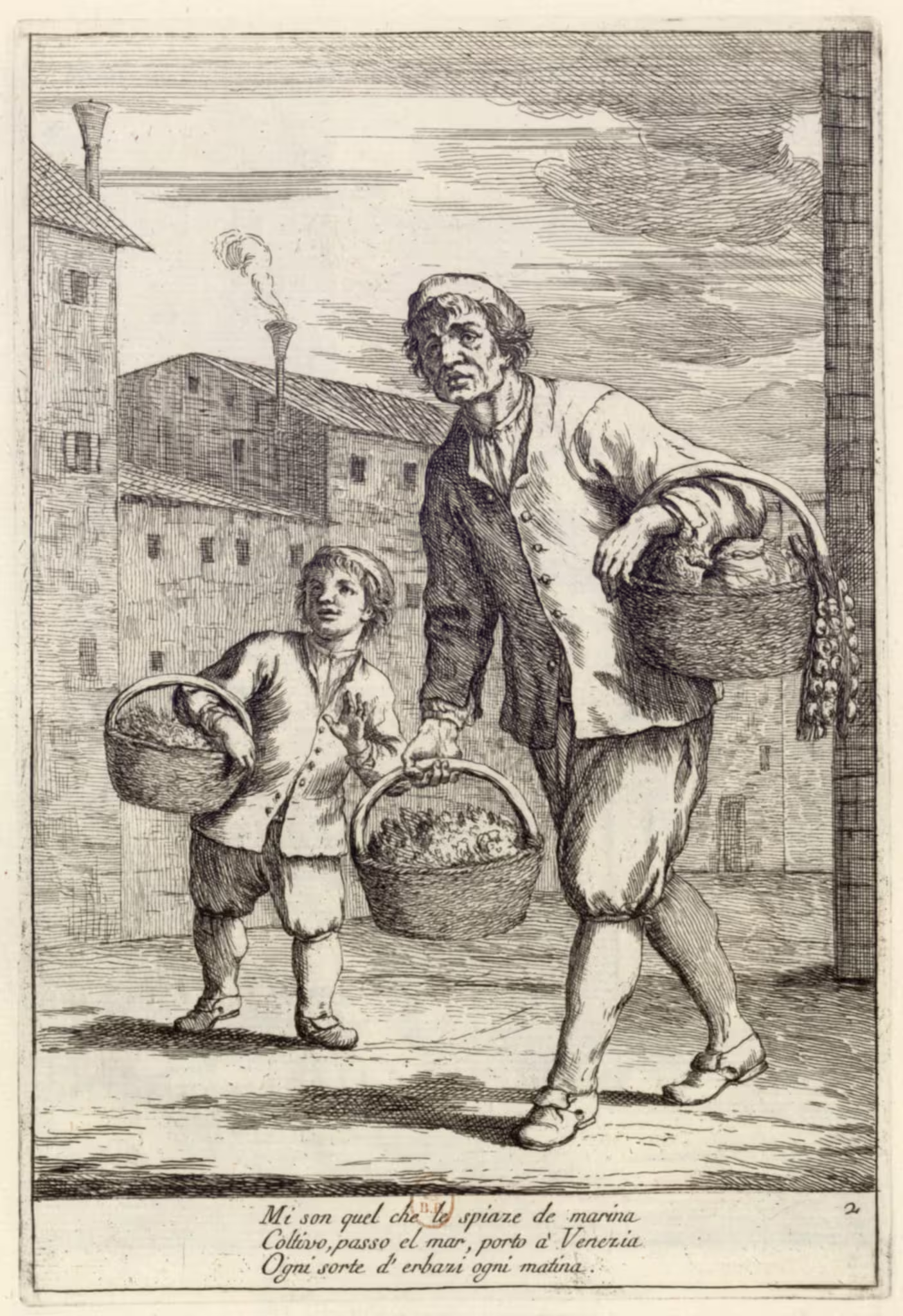The Republic of Venice ended on May 12th, 1797. The decline had been long and slow, but the final blow that led to the fall of Venice and the end of the Serenissima came from France.
Chronology of the main events
- March 1796
Napoleon Bonaparte was given the command of an army of 40-50.000 men for the Italian campaign of the War of the First Coalition. The campaign was primarily against Austria-Hungary, whose interests in North Italy included Lombardy and Milan. Bonaparte was 27 years old. - April 9th, 1796
Napoleon attacked the Kingdom of Sardinia-Piedmont. - April 28th, 1796
After several defeats, the Kingdom of Sardinia-Piedmont accepted an armistice. - May 8th-9th, 1796
Napoleon entered the Austrian-Hungarian province of Lombardy and defeated the Austrians at Fombio. The Austrian governor of Milan fled to Bergamo, in the Venetian dominio di terra. - May 10th, 1796
The French army defeated the Austrians at Lodi, and many of the Austrian troops fled into Venetian territory. - May 11th, 1796
A regiment of two thousand French soldiers crossed the border in pursuit of the Austrians, and arrived at the walls of Crema, a Venetian city. The commander of the ill-defended city, without any orders from Venice, had to allow the French to pass and resupply. - May 12th, 1796 (Crema)
Napoleon Bonaparte arrived at Crema, and reproached the Venetians for having allowed the Austrian troops in, and in general for having given asylum in the past to French nobility fleeing the revolution. - May 12th, 1796 (Venice)
The Venetian senate appointed Nicolò Foscarini as military and civilian leader of the dominio di terra, even though he had not military experience. - May 18th, 1796
Foscarini ordered, from his headquarters in Verona, that all defence of the Venetian territory should concentrate on the fortified cities, like they had done during the Spanish War of Succession in the early 1700s, even if troop numbers and artillery were ruefully insufficient even for that. - May 23rd, 1796
The French demanded supplies for ten thousand men, or they would take it by force. - May 27th, 1796 (Brescia)
Napoleon arrived in Brescia, also on Venetian territory. Here he met two emissaries from Foscarini, who delivered a complaint about the French violation of Venetian neutrality at Crema. Napoleon replied by demanding that Venice immediately expel all Austrian military from its territory. - May 27th, 1796 (Venice)
The Austrian ambassador to Venice tried to obtain supplies for the Austrian troops on Venetian territory, but the Venetians refused out of fear of the French reaction. - May 29th, 1796
French troops crossed the Mincio river by night, and fleeing Austrian troops headed for the Prince-Bishopric of Trent. - May 30th, 1796
Napoleon received a written protest from Foscarini about the damage the French troops had caused, with a demand for reparations. Napoleon summoned Foscarini to a meeting in Peschiera at the south end of the Garda lake. Here he threatened with war against the Republic of Venice and that he intended sending troops to take over Verona. - June 1st, 1796
Foscarini accepted the presence of French troops in Verona, and the French immediately entered the city, which then had both Venetian and French troops present. - Early June 1796
The Venetian senate started mobilisation of troops in Istria, called the fleet back to Venice from further down the Adriatic Sea, and started the organisation of the defence of Venice city and the lagoon area. A formal note of protest for violating the neutrality of Venice was sent to the Directorate in Paris, and two Savi del Consiglio (very high-ranking government officials) went to Napoleon to reassure him that Venice had no ill intentions. Napoleon responded by demanding a substantial supply of firearms from Venice. - June 5th, 1796
Ferdinand, King of the Two Sicilies (most of southern Italy) signs an armistice with Napoleon. - June 10th, 1796
The son of the Duke of Parma arrived in Venice as a refugee. - June 12th, 1796
Napoleon invaded the Papal State. - June 23rd, 1796
The Papal State is forced to accept the occupation of the northern parts of the state. The French here took control of the harbour and naval base of Ancona, thereby gaining access to the Adriatic Sea. - Late June 1796
Venice forbade the entrance into the Venetian lagoon of all foreign ships, as the Adriatic was no longer entirely safe, and the fortifications around and in the lagoon strengthened further. - Mid-July 1796
French troops were present in Crema, Brescia and Bergamo. The French and Austrians agrees on a truce. - July 22nd, 1796
Venice rejects an offer of a formal alliance with France and the Ottoman Turks against the Russia, for fear of the reaction in the Greek and Dalmatian parts of the Dominio di mar, and in the hope of an Austrian counter-offensive. - July 29, 1796
Start of the Austrian counter-offensive. - August 3rd, 1796
The Austrians were defeated at Lonato del Garda. - August 5th, 1796
The Austrians were defeated at Castiglione delle Stiviere and retreated towards Trento. - September 8th, 1796
The Austrians were defeated at Bassano, and retreated towards Mantova leaving large amounts of gear and train behind. - October 15th, 1796
Napoleon created the Cispadane Republic in Lombardy. - October 16th, 1796
Napoleon created the Transpadane Republic of the Duchies of Modena, Parma and bits of the Papal State. - October 29th, 1796
The Austrians, having regrouped, went on the offensive again, and defeated the French at Bassano, after which they entered Vicenza. This too was a violation of Venetian neutrality, this time on behalf of the Austrian-Hungarian Empire. - November 12th, 1796
The French stopped the Austrian advance at Caldiero. - November 17th, 1796
French victory at the Ponte di Arcole. - January 14th, 1797
French victory at the battle of Rivoli Veronese. - February 2nd, 1797
Napoleon took Mantova, the last stronghold of Austrian resistance in NE Italy. - March 13th, 1797
Bergamo rebelled against Venice, instigated by Napoleon. - March 17th, 1797
Brescia rebelled against Venice and declared independence, also instigated by Napoleon. - March 18th, 1797
After street fights between the pro-Venetian and the pro-French factions of Brescia, the podestà fled to Venice while the governor of the dominio di terra was arrested and handed over to the French. - March 22nd, 1797
The Senate sent two emissaries to Napoleon to negotiate, and to resolve the situations in Bergamo and Brescia. Napoleon refused to help, unless Venice entered a formal alliance with the French revolutionary republic and paid six millions gold francs. - March 24th and 25th, 1797
Vicenza, Padova declared their loyalty to the Venetian Republic, followed by Verona, Bassano, Rovigo and many others, including smaller towns around Bergamo. - March 25th to 28th, 1797
The rebels of Bergamo and Brescia occupied Salò and Crema, and declared the Republic of Crema. - Early April 1797
Napoleon, supposedly threatened by an anti-French, probably fake, proclamation, sent the Venetian Senate a demand that they freed all prisoners, reduced all military positions and disarmed all militias. - Mid-April 1797
The Republic of Venice tried through its ambassadors in Paris and Vienna to end the conflict and obtain guarantees for Venetian sovereignty, but to no avail. - April 15th, 1797
Napoleon informed the Senate that France would support and aid the rebels against the ‘tyrannical government’ of the Venetian Republic. The Senate responded with a plea for calm and respect for Venetian neutrality. - April 17th, 1797
At Leoben, Napoleon signed a preliminary peace treaty with Austria, which gave Austria the Venetian Dominio di Terra (except Bergamo) in return for the Austrian evacuation of the Netherlands. - April 17th–25th, 1797
The population and local authorities of Verona rebelled against the French presence in the city, but the uprising was suppressed when French reinforcements surrounded the city walls. - April 20th, 1797
Three ships under French command attempted to enter the Venetian lagoon at San Nicolò. The Fortress of Sant’Andrea opened fire, and killed the French admiral on board. - April 25th, 1797
At a meeting in Graz between Napoleon and a Venetian delegation, Napoleon threatened to destroy the Republic of Venice. - April 28th, 1797
After the meeting at Graz, the Pien Collegio decided to take matters in their own hands, without convoking the Senate, with which Napoleon had expressed displeasure. - April 30th, 1797
In an ultimatum, Napoleon demanded a change of the form of government of the Republic of Venice. - May 1st, 1797
Doge Ludovico Manin called the Maggior Consiglio to discuss the ultimatum. They decide to send another delegation to Napoleon. - May 1st, 1797
Napoleon withdrew his ambassador from Venice, and formally declared war on the Republic of Venice. - May 3rd, 1797
The Maggior Consiglio revoked the order for mobilisation in Dalmatia. - May 4th, 1797
The Maggior Consiglio voted to accept the French ultimatum. The commander of the Fortress of Sant’Andrea was arrested, and so were the three Inquisitori di Stato, who were responsible for the suppression of dissent in the Republic. - May 8th, 1797
The Doge Manin declares that he was willing to abdicate in favour of the Jacobin faction within Venice, and invited all the offices of the state to do the same. One of the Council of the Doge, Francesco Pesaro, urges the Doge to flee the city for Diadora (Zara) in Dalmatia. - May 11th, 1797
The fear of a popular rebellion in Venice was such that the Doge exclaimed: “Tonight we’re not even safe in our own beds.” - May 12th, 1797
The Maggior Consiglio met, amidst fear of conspiracies, popular rebellions and an imminent French attack, and voted to dissolve the Republic of Venice. Less than half the members of the council were present, and as such the decision wasn’t legally valid, but it stood nonetheless. - May 13th, 1797
The Doge issued the last official proclamations in the name of the Republic of Venice. Boats were sent to the mainland for the transport of the French troops to Venice. - May 15th, 1797
Ludovico Manin left the Palazzo Ducale for his private residence. - May 16th, 1797
The Municipalità provvisoria, made up of Venetian Jacobins, took control of the city.





Leave a Reply